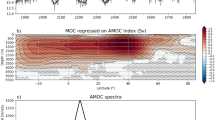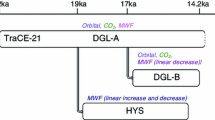Abstract
The stability of the Atlantic meridional overturning circulation (MOC) is investigated for various climate scenario runs, using data from the CMIP3 archive of coupled atmosphere-ocean models. Apart from atmospheric feedbacks, the sign of the salt flux into the Atlantic basin that is carried by the MOC determines whether the MOC is in the single or multiple equilibria regime. This salt advection feedback is analyzed by diagnosing the freshwater and salt budgets for the combined Atlantic and Arctic basins. Consistent with the finding that almost all coupled climate models recover from hosing experiments, it is found that most models feature a negative salt advection feedback in their pre-industrial climate: freshwater perturbations are damped by this feedback, excluding the existence of a stable off-state for the MOC. All models feature enhanced evaporation over the Atlantic basin in future climates, but for a moderate increase in radiative forcing (B1 and 2 CO2 scenarios), there is a decrease of the fresh water flux carried by the MOC into the Atlantic (the deficit is made up by increased fresh water transport by the gyre circulation). In this forcing regime the salt advection feedback becomes less negative: for three models from an ensemble of eight it is positive in a 2 CO2 climate, while two models feature a positive feedback in the pre-industrial climate. For even warmer climates (A1B-equilibrium and 4 CO2) the salt feedback becomes more negative (damping) again. It is shown that the decrease in northward fresh water transport at 34°S by the MOC (in B1-equilibrium and 2 CO2) is due to a reduction of the inflow of intermediate waters relative to thermocline waters, associated with a robust shoaling of the MOC in future, warmer climates. In A1B and 4 CO2 climates northward freshwater transport increases again. The MOC keeps shoaling, but both intermediate and thermocline water masses freshen.






Similar content being viewed by others
References
Broecker WS (1997) Thermohaline circulation, the Achilles heel of our climate system: will man-made CO2 upset the current balance? Science 278:1582–1588
Broecker WS, Peteet DM, Rind D (1985) Does the ocean-atmosphere system have more than one stable mode of operation? Nature 315:21–26
Clark PU, Pisias NG, Stocker TF, Weaver AJ (2002) The role of the thermohaline circulation in abrupt climate changes. Nature 415:863–869
Delworth TL, et al (2006) GFDL’s CM2 global coupled climate models. Part I: formulation and simulation characteristics. J Clim 19:643–674
de Vries P, Weber SL (2005) The Atlantic freshwater budget as a diagnostic for the existence of a stable shut down of the meridional overturning circulation. Geophys Res Lett 32. doi:10.1029/2004GL021450
Dijkstra HA (2007) Characterization of the multiple equilibria regime in a global ocean model. Tellus 59:695–705
Drijfhout SS (2010) The atmospheric response to a THC collapse: scaling relations for the Hadley circulation and the nonlinear response in a coupled climate model. J Clim 23:757–774
Gent P, McWilliams J (1990) Isopycnal mixing in ocean circulation models. J Phys Oceanogr 20:150–155
Gordon C, et al (2000) The simulation of SST, sea ice extent and ocean heat transport in a version of the Hadley centre coupled model without flux adjustments. Clim Dyn 16:147–168
Gordon HB, et al (2002) CSIRO Mk3 climate system model. CSIRO technical report 60, pp 130
Gregory JM, et al (2005) A model intercomparison of changes in the thermohaline circulation in response to increasing atmospheric CO2 concentration. Geophys Res Lett 32. doi:10.1029/2005GL023209
Griffies SM, Harrison MJ, Pacanowski RC, Rosati A (2004) A technical guide tot MOM4, NOAA/GFDL, pp 337
Grootes PM, Stuiver M, White JWC, Johnsen SJ, Jouzel J (1993) Comparison of oxygen isotope records from the GISP2 and GRIP Greenland ice cores. Nature 366:552–554
Hasumi H, et al (2004) K-1 coupled model (MIROC) description. K1 technical report 1, pp 34
Huisman SE, den Toom M, Dijkstra HA, Drijfhout SS (2010) An indicator of the multiple equilibria regime of the Atlantic meridional overturning circulation. J Phys Oceanogr 40:551–567
Jungclaus JH, et al (2006) Ocean circulation and tropical variability in the coupled model ECHAM5/MPI-OM. J Clim 19:3952–3972
Kim SJ, Flato GM, de Boer GJ, McPharlane NA (2002) A coupled climate model simulation of the last glacial maximum, part I: transient multi-decadal response. Clim Dyn 19:515–537
Latif ME, Roeckner E, Mikolajewicz U, Voss R (2000) Tropical stabilization of the thermohaline circulation in a greenhouse warming simulation. J Clim 13:1809–1813
Leduc G, Vidal L, Tachikawa K, Rostek F, Sonzogni C, Beaufort L, Bard E (2007) Moisture transport across Central America as a positive feedback on abrupt climatic changes. Nature 445:909–911
Lenton TM, et al (2007) Effects of atmospheric dynamics and ocean resolution on bi-stability of the thermohaline circulation examined using the Grid ENabled Integrated Earth system modelling (GENIE) framework. Clim Dyn 29:591–613
Lohmann G (2003) Atmospheric and oceanic freshwater transport during weak Atlantic overturning circulation. Tellus 55:438–449
Manabe S, Stouffer RJ (1988) Two stable equilibria of a coupled ocean-atmosphere model. J Clim 1:841–863
Pardaens AK, Banks HT, Gregory JM, Rowntree PR (2003) Freshwater transports in HadCM3. Clim Dyn 21:177–195
Rahmstorf S (1996) On the freshwater forcing and transport of the Atlantic thermohaline circulation. Clim Dyn 12:799–811
Rahmstorf S (2000) The thermohaline ocean circulation—a system with dangerous thresholds? Clim Change 46:247–256
Rahmstorf S, et al (2005) Thermohaline circulation hysteresis:a model intercomparison. Geophys Res Lett 32. doi:10.1029/2005GL023655
Schmittner A, Latif M, Schneider B (2005) Model projections of the North Atlantic thermohaline circulation for the 21st century assessed by observations. Geophys Res Lett 32. doi:10.1029/2005GL024368
Stommel H (1961) Thermohaline convection with two stable regimes of flow. Tellus 13:224–230
Stouffer RJ, et al (2006) Investigating the causes of the response of the thermohaline circulation to past and future climate changes. J Clim 19:1365–1387
Trenberth KE, Caron JM (2001) Estimates of meridional atmosphere and ocean heat transports. J Clim 14:3433–3443
Vellinga M, Wood RA (2002) Global climatic impacts of a collapse of the Atlantic thermohaline circulation. Clim Change 54:251–267
Weber SL, Drijfhout SS (2007) Stability of the Atlantic meridional overturning circulation in the last glacial maximum climate. Geophys Res Lett 34. doi:10.1029/2007GL031437
Weber SL, Drijfhout SS, Abe-Ouchi A, Crucifix M, Eby M, Ganopolski A, Murakami S, Otto-Bliesner B, Peltier WR (2007) The modern and glacial overturning circulation in the Atlantic ocean in PMIP coupled model simulations. Clim Past 3:51–64
Weijer W, de Ruijter WPM, Dijkstra HA, van Leeuwen PJ (1999) Impact of interbasin exchange on the Atlantic overturning circulation. J Phys Oceanogr 29:2266–2284
Yin J, Stouffer RJ (2007) Comparison of the stability of the Atlantic thermohaline circulation in two coupled atmosphere-ocean general circulation models. J Clim 20:4293–4315
Acknowledgments
Computer resources were funded by the National Computing Facilities Foundation (NCF). We thank Michael Kliphuis for technical support and Vanessa Pedinotti for computational support. The manuscript benefitted from remarks from Geert-Jan van Oldenborgh and Andrea Cimatoribus. We acknowledge the international modeling groups for providing their data for analysis, PCMDI and ESG for making these data available. Part of this research was carried out in the framework of the Dutch Climate Change and Spatial Planning program (BSIK).
Author information
Authors and Affiliations
Corresponding author
Rights and permissions
About this article
Cite this article
Drijfhout, S.S., Weber, S.L. & van der Swaluw, E. The stability of the MOC as diagnosed from model projections for pre-industrial, present and future climates. Clim Dyn 37, 1575–1586 (2011). https://doi.org/10.1007/s00382-010-0930-z
Received:
Accepted:
Published:
Issue Date:
DOI: https://doi.org/10.1007/s00382-010-0930-z




